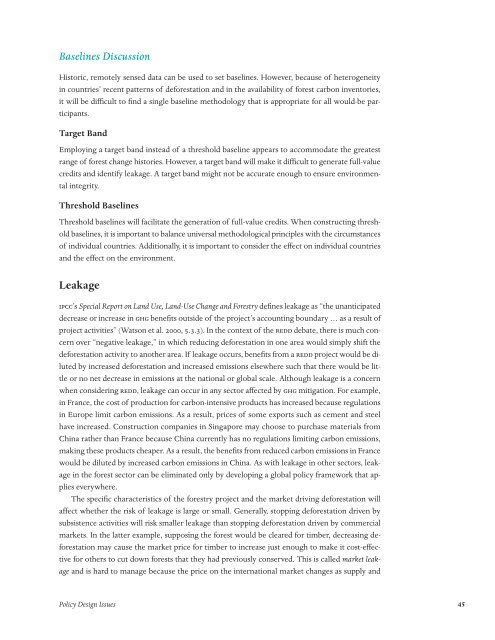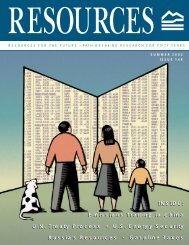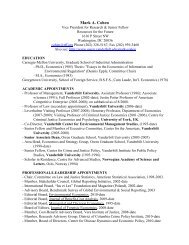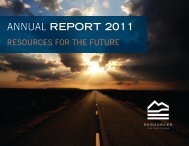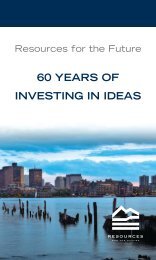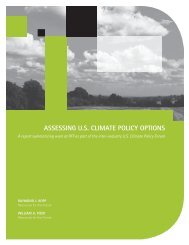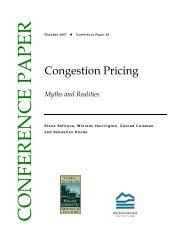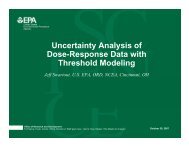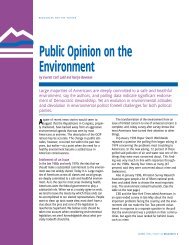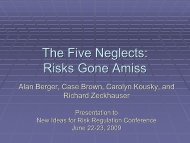Policies to Reduce Emissions from Deforestation and Degradation ...
Policies to Reduce Emissions from Deforestation and Degradation ...
Policies to Reduce Emissions from Deforestation and Degradation ...
Create successful ePaper yourself
Turn your PDF publications into a flip-book with our unique Google optimized e-Paper software.
Baselines Discussion<br />
His<strong>to</strong>ric, remotely sensed data can be used <strong>to</strong> set baselines. However, because of heterogeneity<br />
in countries’ recent patterns of deforestation <strong>and</strong> in the availability of forest carbon inven<strong>to</strong>ries,<br />
it will be difficult <strong>to</strong> find a single baseline methodology that is appropriate for all would-be participants.<br />
Target B<strong>and</strong><br />
Employing a target b<strong>and</strong> instead of a threshold baseline appears <strong>to</strong> accommodate the greatest<br />
range of forest change his<strong>to</strong>ries. However, a target b<strong>and</strong> will make it difficult <strong>to</strong> generate full-value<br />
credits <strong>and</strong> identify leakage. A target b<strong>and</strong> might not be accurate enough <strong>to</strong> ensure environmental<br />
integrity.<br />
Threshold Baselines<br />
Threshold baselines will facilitate the generation of full-value credits. When constructing threshold<br />
baselines, it is important <strong>to</strong> balance universal methodological principles with the circumstances<br />
of individual countries. Additionally, it is important <strong>to</strong> consider the effect on individual countries<br />
<strong>and</strong> the effect on the environment.<br />
Leakage<br />
IPCC’s Special Report on L<strong>and</strong> Use, L<strong>and</strong>-Use Change <strong>and</strong> Forestry defines leakage as “the unanticipated<br />
decrease or increase in GHG benefits outside of the project’s accounting boundary … as a result of<br />
project activities” (Watson et al. 2000, 5.3.3). In the context of the REDD debate, there is much concern<br />
over “negative leakage,” in which reducing deforestation in one area would simply shift the<br />
deforestation activity <strong>to</strong> another area. If leakage occurs, benefits <strong>from</strong> a REDD project would be diluted<br />
by increased deforestation <strong>and</strong> increased emissions elsewhere such that there would be little<br />
or no net decrease in emissions at the national or global scale. Although leakage is a concern<br />
when considering REDD, leakage can occur in any sec<strong>to</strong>r affected by GHG mitigation. For example,<br />
in France, the cost of production for carbon-intensive products has increased because regulations<br />
in Europe limit carbon emissions. As a result, prices of some exports such as cement <strong>and</strong> steel<br />
have increased. Construction companies in Singapore may choose <strong>to</strong> purchase materials <strong>from</strong><br />
China rather than France because China currently has no regulations limiting carbon emissions,<br />
making these products cheaper. As a result, the benefits <strong>from</strong> reduced carbon emissions in France<br />
would be diluted by increased carbon emissions in China. As with leakage in other sec<strong>to</strong>rs, leakage<br />
in the forest sec<strong>to</strong>r can be eliminated only by developing a global policy framework that applies<br />
everywhere.<br />
The specific characteristics of the forestry project <strong>and</strong> the market driving deforestation will<br />
affect whether the risk of leakage is large or small. Generally, s<strong>to</strong>pping deforestation driven by<br />
subsistence activities will risk smaller leakage than s<strong>to</strong>pping deforestation driven by commercial<br />
markets. In the latter example, supposing the forest would be cleared for timber, decreasing deforestation<br />
may cause the market price for timber <strong>to</strong> increase just enough <strong>to</strong> make it cost-effective<br />
for others <strong>to</strong> cut down forests that they had previously conserved. This is called market leakage<br />
<strong>and</strong> is hard <strong>to</strong> manage because the price on the international market changes as supply <strong>and</strong><br />
Policy Design Issues 45


